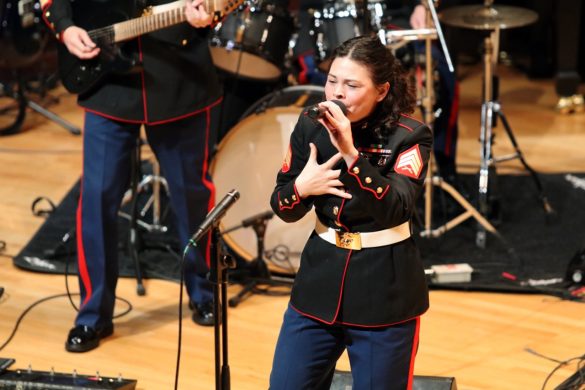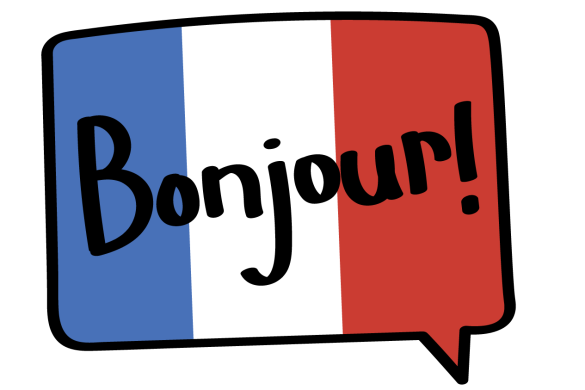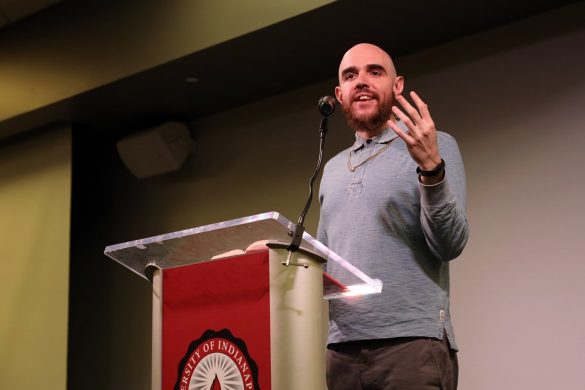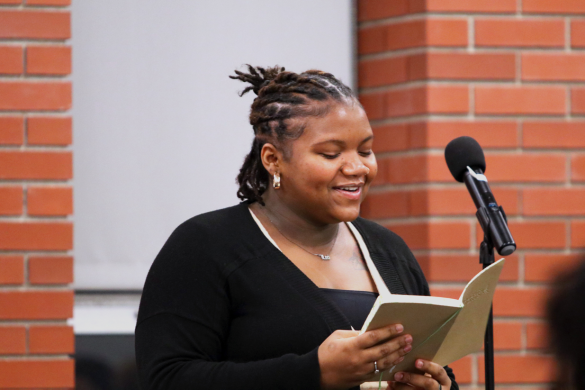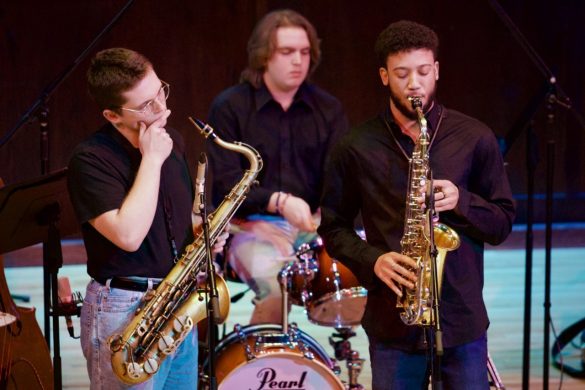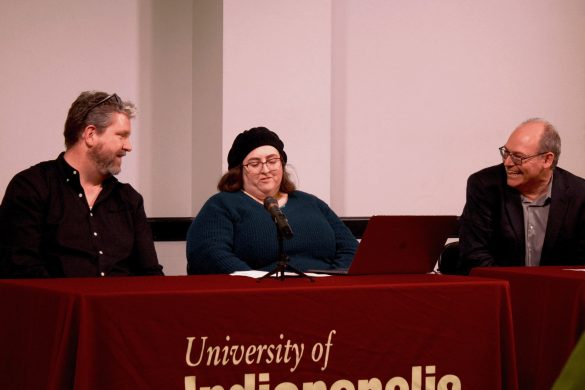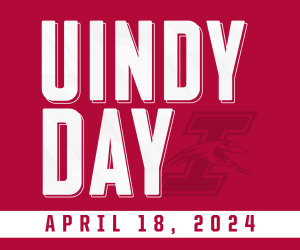
he UIndy Music Department faculty including Haruka Ostojic (far left), Rebecca Sorley (center) and. E.J. Choe (right) performed as part of the Molto Piano ensemble on Jan. 29 in the Christel DeHaan Fine Arts Center. Their performance included music from famed composers like Claude Debussy and Aaron Copland. Photo by Johana Rosendo
With up to six hands at a time on one piano, the University of Indianapolis music faculty put on a performance at the Ruth Lilly Performance Hall on Jan. 29 as part of the Faculty Artist Series. The ensemble, Molto
Piano, presented a concert that was titled “Dancing at the Piano.” It featured two pianos played in a variety of ways by the faculty. The chosen pieces went along with the dance theme.
“Coming into this I knew the theme for this year was dance, and you know, it’s limited in what to look for, so I went after mostly recognized [composers like] Brahms and Dvork where as Haruka and Becky went for little less known pieces like the Debussy piece,” Adjunct Associate Professor E.J. Choe said. “We played most of [this] repertoire for the first time. We thought about who our audience was. This has been by far one of those events that people enjoy coming back to with the molto piano, so when the dance theme was decided, we went for what was the most enjoyable.”
The concert consisted of other well-known pieces by composers such as Claude Debussy, Sergei Rachmaninoff and Aaron Copland. Some of the songs were known for being in relation to video games, sports and movies such as “Star Wars.”
“We chose a theme and then I put out some suggestions and others listened to some music that worked with the theme,” Professor of Music Rebecca Sorley said. “I think the theme comes first then we can come up with things that seem to fit with it.”
The concert was different from others since the faculty had to coordinate themselves to be able to play together on one piano. Aside from coordination, the faculty members would trade places and try out the other parts in order to get to know the music better.
“I would have the whole score and I would sometimes, when I’m wasn’t secure about my part, I would play the other part to see what was really important and what she [the other pianist] would need to hear for me to emphasise,” Choe said. “It’s almost like being an orchestra player. As a violin player, you carry the melody, but then you also hear the other parts. I mean you kind of rely on the conductor to tell you where to come in, but we don’t have a conductor. So that’s why we have to know the other part. So it went well. I was not nervous at all. I don’t think any of us were nervous at all. We actually had fun.”
The composers that created these pieces had created them with the intent of having them played by an orchestra, which limited the players.
“Some of these pieces are orchestra pieces so when you hear it form an orchestra it’s very nice and has nice substance,” Choe said. “With piano, it has limitations so you have to kind of work it out so you can do as much as you can.”
The concert consisted of four faculty members. There were times when there was one person at each of the two pianos, times when there were two people at the piano and then times when there were three people playing at one piano.
“It went really well,” Choe said. “It went better than our rehearsals actually because to get four people to rehearse the different combinations as you saw, just trying to work out our rehearsal schedule had been crazy. And we’re always in a rush to teach another student or teach classes. So we would just talk through our playing and really focus like, ‘Next time let’s do this,’ and one of us, well mostly me, would forget to repeat because there were a lot of repeat.”
“We would have notes written all over [the music], ” Choe said. “With the performance as a whole, you know you said you had never heard molto [multiple] pianos, we always play as ensemble players and accompanying other instrumentalists, but it’s hard to get that many pianists together to play a program like this. So it was pure joy and it went very well.”
The audience consisted of a mix of students, faculty and community members in attendance for the faculty ensemble.
“We always invite people, potential students for the university and community members,” Sorley said. “It’s a great thing for the community. I guess it’s a good community outreach to do these concerts and they are all free. Each of us teaches a class that requires a concert report. So we encourage them to come to one that we are in, so then we can help them with the concert report since we know the repertoire.”
Choe compared the faculty concert to the other achievements that professors attain in their academic career. She gave the example of how a history professor can write a textbook or a science teacher can be a part of a research project to show their achievements and knowledge. For music teachers, this is the way that they show their achievements, according to Choe. They put on performances such as this one and get reviewed by publications such as the Chicago Tribune, Choe said.
“It’s very important for us, the community and for our students because they need to see that we have the right to teach here,” Choe said. “It inspires our students. Like this week they were like, ‘Wow that was really good,’ and I was like, ‘Yeah now do you think I have the right to teach you?’ So it’s inspiring both ways amongst colleagues and students.”
Playing a concert such as this one, was different than what can be seen at a normal orchestra concert consisting of all the variety of instruments, according to Choe.
“Like violinists, they have to play in a chamber or orchestra setting,” Choe said. “Pianists don’t. We are either accompanying other instrumentalists or playing as a soloist, so it was nice to play with one another. That’s an opportunity you don’t normally get to do. Now, there are competitions where you can play as a duo, although normally as a duet, duet meaning one piano four hands and duo meaning one piano on each side,” Choe said. “Since we don’t get to do it as much, it’s an opportunity. It’s a gift of time. It’s helpful when you like the people you work with of course.”
The Music Department Recital on Feb. 7 at 12 p.m. in the Ruth Lilly Performance Hall will feature performances from the Music Department.
